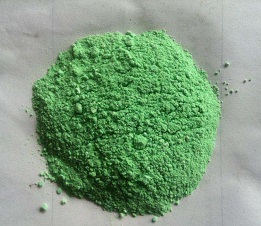Nickelcarbonat Chemische Eigenschaften,Einsatz,Produktion Methoden
ERSCHEINUNGSBILD
HELLGRüNE KRISTALLE.
CHEMISCHE GEFAHREN
Zersetzung beim Erhitzen und bei Kontakt mit S?uren unter Bildung von Kohlendioxid (s. ICSC 0021). Reagiert sehr heftig mit Anilin, Schwefelwasserstoff, entzündlichen L?semitteln, Hydrazin und Metallpulvern, besonders Zink, Aluminium und Magnesium. Feuer- und Explosionsgefahr.
ARBEITSPLATZGRENZWERTE
TLV: (als Nickel, unl?sliche anorganische Verbindungen) 0,2 mg/m?(als TWA); Krebskategorie A1(best?tigte krebserzeugende Wirkung beim Menschen); (ACGIH 2005).
MAK: (Einatembare Fraktion) Sensibilisierung der Atemwege und der Haut; Krebserzeugend Kategorie 1; (DFG 2005).
AUFNAHMEWEGE
Aufnahme in den K?rper durch Inhalation des Aerosols und durch Verschlucken.
INHALATIONSGEFAHREN
Verdampfung bei 20°C vernachl?ssigbar; eine gesundheitssch?dliche Partikelkonzentration in der Luft kann jedoch beim Dispergieren schnell erreicht werden.
WIRKUNGEN BEI KURZZEITEXPOSITION
WIRKUNGEN BEI KURZZEITEXPOSITION: Die Substanz reizt die Haut.
WIRKUNGEN NACH WIEDERHOLTER ODER LANGZEITEXPOSITION
Wiederholter oder andauernder Kontakt kann zu Hautsensibilisierung führen. Wiederholte oder andauernde Inhalation kann asthmatische Beschwerden hervorrufen. M?glich sind Auswirkungen auf die Lunge. Krebserzeugend für den Menschen.
LECKAGE
Verschüttetes Material in Beh?ltern sammeln; falls erforderlich durch Anfeuchten Staubentwicklung verhindern. Reste sorgf?ltig sammeln. An sicheren Ort bringen. Pers?nliche Schutzausrüstung: Atemschutzger?t, P3-Filter für giftige Partikel. NICHT in die Umwelt gelangen lassen.
R-S?tze Betriebsanweisung:
R22:Gesundheitssch?dlich beim Verschlucken.
R40:Verdacht auf krebserzeugende Wirkung.
R43:Sensibilisierung durch Hautkontakt m?glich.
R50/53:Sehr giftig für Wasserorganismen, kann in Gew?ssern l?ngerfristig sch?dliche Wirkungen haben.
S-S?tze Betriebsanweisung:
S22:Staub nicht einatmen.
S36/37:Bei der Arbeit geeignete Schutzhandschuhe und Schutzkleidung tragen.
S60:Dieses Produkt und sein Beh?lter sind als gef?hrlicher Abfall zu entsorgen.
S61:Freisetzung in die Umwelt vermeiden. Besondere Anweisungen einholen/Sicherheitsdatenblatt zu Rate ziehen.
Chemische Eigenschaften
Nickel carbonate is a light green crystalline substance, which is almost insoluble (0.093 g/L) in water (25°C), nonsoluble in hot water, and soluble in acids. Nickel carbonate is available primarily as basic nickel carbonate (NiCO3· 2Ni(OH)2 · 4H2O), which is not soluble in water and soluble in ammonia and dilute acids. In the natural environment, nickel carbonate tetrahydrate can be found as zaratite.

Physikalische Eigenschaften
NiCO
3: Light green rhombohedral crystals; decomposes on heating; practically insoluble in water, 93 mg/L at 25°C; dissolves in acids.
2NiCO
3?3Ni(OH)
2?4H
2O: Light green crystals or brown powder; decomposes on heating; insoluble in water; decomposes in hot water; soluble in acids and in ammonium salts solutions.
Zaratite: Emerald greed cubic crystals; density 2.6 g/cm
3; insoluble in water; soluble in ammonia and dilute acids.
Verwenden
Nickel carbonate is used to prepare nickel catalysts and several specialty
compounds of nickel. It also is used as a neutralizing agent in nickel plating
solutions. Other applications are in coloring glass and in the manufacture of
ceramic pigments.
synthetische
Anhydrous nickel carbonate is produced as a precipitate when calcium carbonate is heated with a solution of nickel chloride in a sealed tube at 150°C. Alternatively, treating nickel powder with ammonia and carbon dioxide followed by boiling off ammonia yields pure carbonate.
When sodium carbonate is added to a solution of Ni(II) salts, basic nickel carbonate precipitates out in impure form.
Reaktionen
Nickel carbonate is the starting material for preparing many nickel salts. It reacts with dilute acids evolving carbon dioxide, and upon evaporation of the solution corresponding nickel salts are formed. The nitrate, sulfate and phosphate salts are prepared from carbonate. Similarly, reactions with hydrofluoric, hydrochloric, hydrobromic, or hydriodic acids yield hydrated nickel halides: namely NiF2•4H2O, NiCl2•6H2O, NiBr2•6H2O, and NiI2•6H2O, respectively:
NiCO3 + HCl → NiCl2•6H2O + CO2
NICKEL CARBONATE 611Nickel carbonate decomposes to nickel oxide when strongly ignited:
NiCO3 → NiO + CO2
Nickel carbonate, when dissolved in aqueous thiocyanic acid, yields a yellow brown precipitate of hydrated nickel thiocyanate:
2 NiCO3 + 2HSCN → Ni(SCN)2 + CO2 + H2O
Nickel carbonate forms many double salts, such as, Na2CO3•NiCO3•10H2O with alkali metal carbonates. However, such double carbonates usually are prepared by mixing an alkali metal or ammonium bicarbonate solution with a nickel salt solution, followed by crystallization.
Hazard
Confirmed carcinogen.
Sicherheitsprofil
Confirmed human
carcinogen. When heated to decomposition
it emits toxic vapors of nickel.
Nickelcarbonat Upstream-Materialien And Downstream Produkte
Upstream-Materialien
Downstream Produkte

